IOS Lecture on “Budget and Social Sector Implications
(Social Justice, Women and Child Health, Education and Minorities)”
March 27, 2015 at IOS Conference Hall, New Delhi
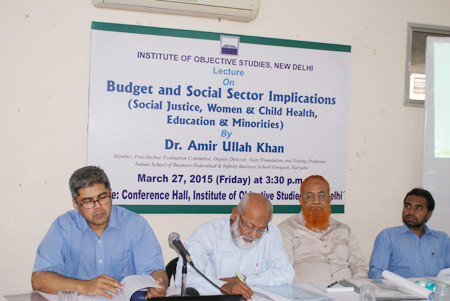
L-R: Dr. Amir Ullah Khan, Deputy Director, Gate Foundation and Visiting Professor, Indian School of Business, Hyderabad & Infinity Business School Gurgaon, Haryana; Dr. Mohammad Manzoor Alam, Chairman, IOS; Dr. Waquar Anwar, an expert from the Indian Centre for Islamic Finance (ICIF), New Delhi; Dr. Mohd. Aftab Alam, Assistant Professor of Political Science, Zakir Husain College, New Delhi
New Delhi, March 27: A lecture on “Budget and Social Sector Implications (Social Justice, Women and Child Health, Education and Minorities)” was organised by the Institute of Objective Studies at its conference hall here today. Speaking on the subject, Member, Post-Sachar Evaluation Committee, Deputy Director, Gate Foundation and Visiting Professor, Indian School of Business, Hyderabad and Infinity Business School, Gurgaon, Dr. Amir Ullah Khan, held that Union Finance Minister Arun Jaitley’s budget for the financial year 2015-16 was a confused statement of the vision of what the government wanted to do and how it intended to achieve it.
The Finance Minister had started his speech by talking about agriculture and extending eight and a half trillion rupees to farmers. But he failed to explain what would be the government’s role in something that was and should be between banks and farmers. He also did not explain that the priority farm loans were given at 7 per cent to all farmers and at 4 per cent to those farmers who made timely repayments. These loans were a major burden on banks that were already reeling under non-performing assets or bad loans totalling more than Rs. 2.8 lakh crore, he said.
Dr. Amir Ullah Khan noted that the dichotomy was further displayed by nearly 50 per cent cut in the allocation to the ministry of women and child development. Budget for primary education and the ministry of environment had been slashed. Whether the goal of universal education under the present circumstances would be achieved was anybody’s guess. He held that cuts were everywhere the most blatant being the severe cut in the budget for health. While observing that good health was a necessity for both quality of life and productivity of a person to support his family, Jaitley said that providing medical services in each village and city was absolutely essential. But then he slashed the health budget by nearly 20 per cent.
This only explained a big gap between principle and practice. Arguing for increase in the allocation to health sector, he said it was imperative as life expectancy had now gone up to 65 years compared to 37 years in 1947. Highlighting poor health care in the country, he said that only 50 per cent children were vaccinated against various diseases. Nearly forty-nine percent population was poor and had no access to health and medical care with the result that general health continued to be a great problem. So was the case with child health, he said. It was a pity that India was the only country where a pregnant mother lost weight.
Dr. Amir Ullah painted a rosy picture of the Indian economy by stating that last year India was the fourth largest economy of the world. If the present trend continued, it was poised to emerge as the largest or the second largest economy of the world in the coming years. He maintained that India’s growth of income rose in the last 20 years and would take a further jump in the next 20 years. But at the same time inequality in terms of income had widened on a scale which was never seen before. India’s 360 million population accounting for 36 percent was miserably poor. Commenting on the largesse distributed to the corporate sector by way of reduction in corporate tax from 30 to 25 per cent over a period of four years he said that this was the “achchhe din” for the sector. He held that the Finance Minister had given a post-dated cheque to the corporate sector.
An exuberant corporate sector responded by hailing the move, but refused to put its money on the budget and the stock market fell by about 250 points. This was the most bizarre outcome of the budget. He observed that the industry leaders were falling over each other in trying to compliment the government, but their fund managers were selling their stocks and by the end of the day the government demonstrated how confused it was. He said that on one hand it swore that it would end subsidies and on the other it went straight ahead to allocate Rs. 2.27 lakh crore in the name of attracting huge investment. In spite of big concessions to investors, no fresh investment was coming to India. Similarly, manufacturing sector was registering a negative trend which must cause concern to our planners, he noted.
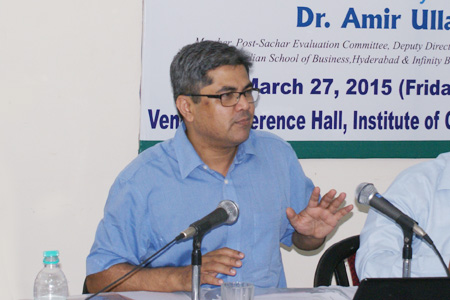
Dr. Amir Ullah Khan, Deputy Director, Gate Foundation and Visiting Professor, Indian School of Business, Hyderabad & Infinity Business School Gurgaon, Haryana deliveres the lecture
Dr. Amir Ullah Khan underlined the ambivalence of the government on MGNREGA by saying that just a day before Prime Minister Narendra Modi had decided that the Rural Employments Guarantee Scheme was the most useless scheme and ridiculed the Congress Party by terming it as a “living example of your failure”. But Arun Jaitley announced a hike of Rs. 5,000 crore for the very scheme which was objected to the BJP government. Referring to the new scheme for minorities, “Nai Manzil”, announced in the budget, he said that the scheme was aimed at working with school dropouts among the minorities. But, despite the new scheme in place, there was no increase in the budgetary allocation for the Ministry of Minority Affairs which remained a little more than Rs. 3,000 crore. The Finance Minister made no mention of an amount about Rs. 600 crore which remained unspent in the last financial year, he added.
Attributing price spiral to stagnant production and rising demand of pulses and edible oil in both India and China, Dr. Amir Ullah Khan said that the pulse production had not increased for the last seven years. Surprisingly, Afghanistan had emerged as a major producer of pulses, he noted. He said that demographic changes were increasing the rural urban divide. To buttress his point, he explained that in 2001, eighty percent population lived in villages and 20 percent in urban areas. But the composition changed in 2011 with the villages accounting for 65 per cent population and cities inhabited by 35 per cent. This followed the Western trend of urbanisation, he said.
Dr. Khan pointed out that an amount of Rs. 7,000 crore was earmarked for developing a 100 smart cities in the last year’s budget, but it found no mention this year. Nobody knew what happened to this scheme. While ignoring the promise made to the armed forces personnel for ‘one rank and one pension’, the defence expenditure had been hiked by Rs. 25,000 crore. This year’s budget made a provision of Rs. 2,510 crore for “Digital India”, a great scheme which required 7.5 lakh kilometers of optical fibre to be laid to connect all villages across the country. But it had not been clarified who would pay for this mammoth project. Commenting on the Ganga Action Plan, he said that the order to about 600 tanneries, owned mostly by Muslims to close down, would deal a heavy blow to them as thousands of workers would be rendered jobless.
More than the Ganga clean-up, the project was aimed at breaking the economic backbone of Muslims, he said. Incidentally, the Ministry of Water Resources, which looked after the project, was headed by Uma Bharti, a known Muslim-baiter. Opining that the lack of capital formation caused poverty, he said that 49 per cent of the population of the country was still poor. He concluded by remarking that with huge cuts in spending delayed targets for fiscal discipline and lip service paid to most of the schemes, the Union budget failed to lift sentiments among all segments of society.
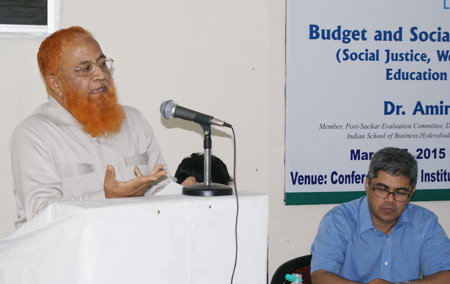
Dr. Waquar Anwar, Indian Centre for Islamic Finance (ICIF), New Delhi sharing his remarks on the topic
Dr. Aftab Alam from the department of Political Science, Zakir Hussain College, Delhi University, pointed out that it was politics that decided the budget. Terming the budget as pro-corporate, he said that big relief given to the corporate sector belied the pro-poor claims of the Central government. Dr. Waqar Anwar, an expert from the Indian Centre for Islamic Finance (ICIF), held that despite a huge mandate, the ruling party had not measured up to the expectations of the people. Referring to the scrapping of the Planning Commission by the present government, he said that the planning body was responsible for approving annual budget outlays of states and various central ministries. Besides, it used to draft five year plans. But it had been replaced with a new panel called NITI Ayog (National Institute for Transforming India) which had an advisory role only. Earlier, multi-sectoral and several other schemes being implemented by the states, were monitored by the Planning Commission. But the Central government had now washed its hands off the responsibility to review the progress of schemes. While striking a note of dismay over doing nothing worthwhile for the minorities, he said that much significance had been attached to yoga.
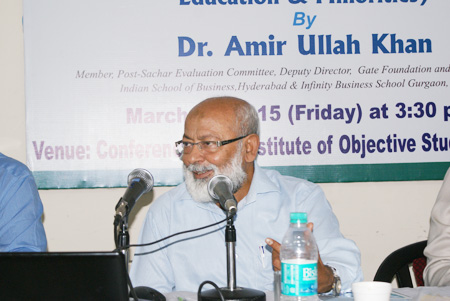
Dr. Mohammad Manzoor Alam, Chairman, IOS expresses his presidential remarks
The Chairman of IOS, Dr. Mohammad Manzoor Alam, in his presidential remarks expressed concern that today wealth was concentrated in a few hands. Referring to a book that was published in 1984, he said that the book revealed that only 18 percent people had accumulated world’s wealth into their hands. Common people were still being exploited and made to suffer. He stated that the Government of India had asked NGOs receiving funds under Foreign Contributions Regulation Act (FCRA) to renew their registration by 2016. This strengthened the fear that while the NGOs run by the minorities would lose registration, the NGOs promoted by the Hindutva brigade would be spared. Raising the issue of the order to nearly 600 tanning units and other industries in Kanpur and its adjoining areas along the river Ganga, to shut down, he said that Muslims would be the worst sufferers as a majority of the units were owned by them. He noted that though the area was also dotted with chemical manufacturing industries which were more lethal, yet no action against them was contemplated.
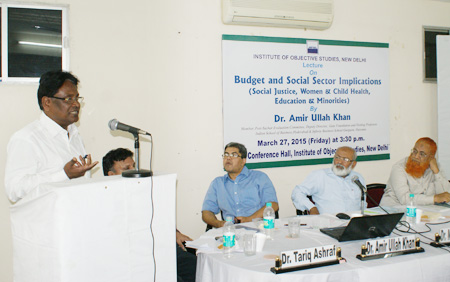
Advocate Arun Kumar Manjhi, shares his view
Social activist and advocate Arun Kumar Manjhi lashed out at the Ganga Mukti Abhiyan by saying that it was aimed at targeting Muslims and fishermen’s community. A great conspiracy was hatched by the corporate sector in collusion with Hindutva forces to deprive the minorities and other weaker sections of their livelihood. Quoting a World Bank report which said that India’s 43 percent population was poor, he held that the corporate sector engaged pliant economists who could solicit in their favour. Similarly, it was no secret that the corporate sector influenced decisions of the Supreme Court through lawyers who filed proxy PILs. The court in turn did not ignore the huge investment made by big business house.
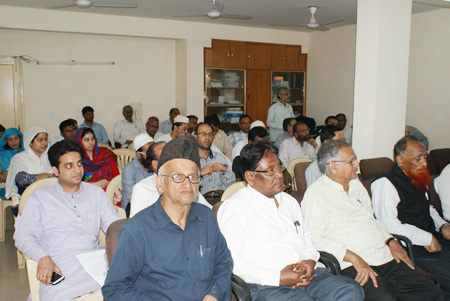
A view of audience
Earlier, the programme began with the recitation of a verse from the Holy Quran by Hafiz Athar Husain. The proceedings were conducted by Dr. Tariq Ashraf of the Civil Society Network. Those who attended the lecture included the Secretary General of the IOS, Prof. ZM Khan, SM Kirmani, Dr. Abdul Azim Akhtar, Prof. Hasina Hashia from JMI, Yasir Imam, Pervez Ashrafi, Md. Farooq Kazmi, Md. Salahuddin, Shahid Habib, H. Abdul Raqeeb, Shamshad Akram, besides several research scholars from the JMI and other universities.
|